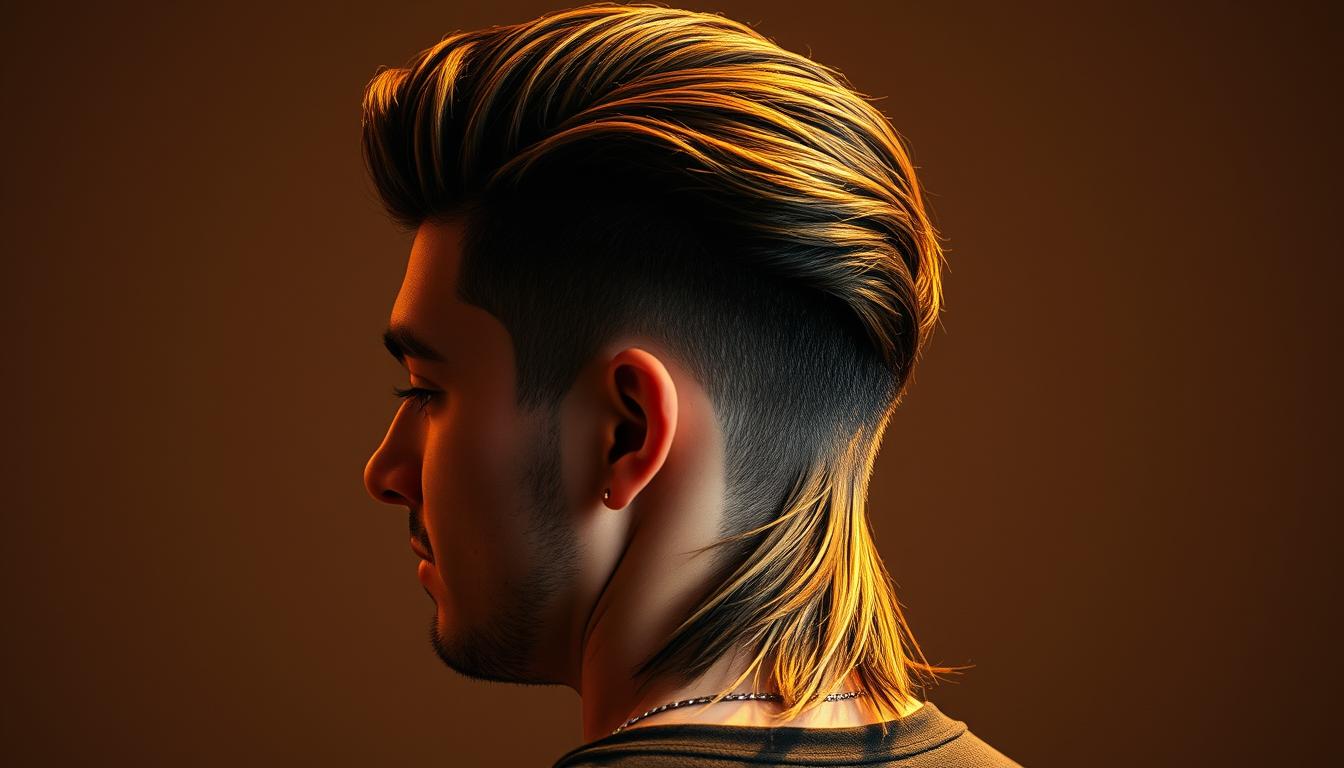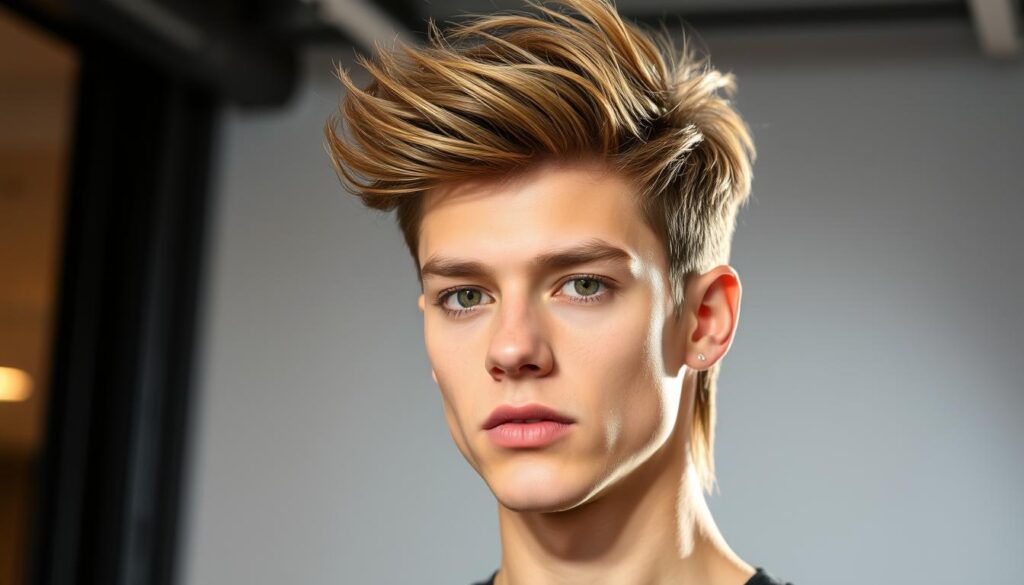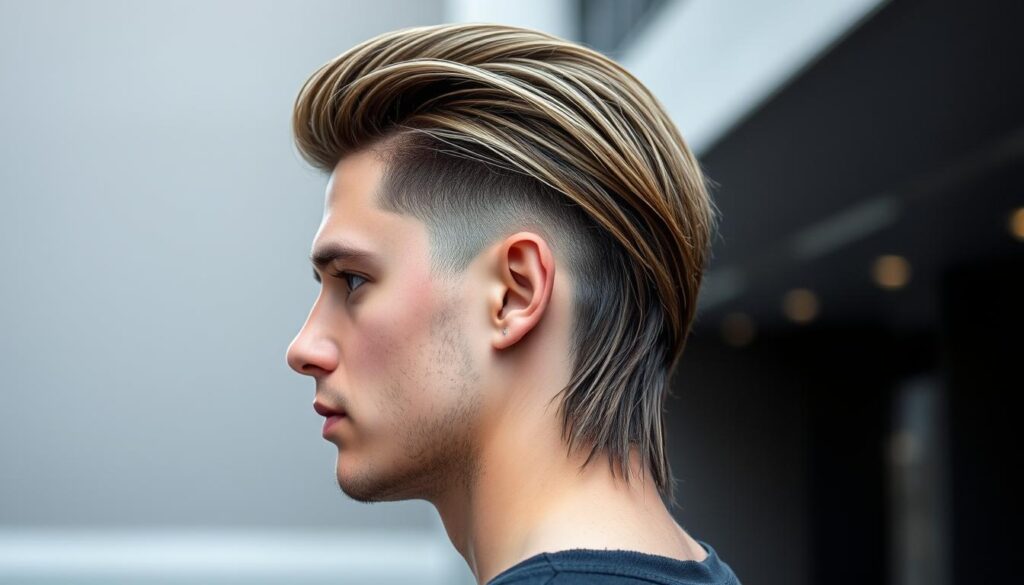
What if the hairstyle you thought was outdated has secretly become the ultimate symbol of modern rebellion? The answer lies in barbershops and TikTok feeds across America, where a bold hybrid cut is rewriting the rules of men’s grooming.
This isn’t your dad’s mullet. Today’s version combines sharp barbering techniques with nostalgic flair, creating a look that works equally well in boardrooms and concert venues. Social media platforms have transformed this once-polarizing style into a viral sensation, with over 2.3 million #ModernMullet posts on Instagram alone.
The magic happens in the contrast: tapered sides that frame your face meet longer, textured layers at the crown and neckline. This balance lets you maintain professionalism while subtly showcasing your personality. Whether you prefer a subtle transition or dramatic graduation, the cut adapts to your hair type and lifestyle.
Key Takeaways
- Blends 1980s nostalgia with contemporary barbering for a fresh aesthetic
- Offers versatility across hair types and personal style preferences
- Gained popularity through viral social media trends and celebrity adoptions
- Balances professional appearance with edgy individuality
- Requires minimal daily styling for maximum impact
- Represents a cultural shift toward personalized grooming standards
Introduction to the Modern Fade Mullet Trend

Once considered a relic, this cut now dominates streets and screens alike. Barbers report clients from all walks of life requesting versions that blend business-appropriate neatness with rockstar energy. The secret? Precision blending where sharp fades meet flowing lengths.
Your hair texture becomes the blueprint. Curly types get defined volume up top with tamed sides. Straight locks showcase angular contrasts between cropped temples and cascading backs. Wavy patterns strike the perfect balance – enough texture for movement without looking unruly.
Social media fueled the fire. Stylists post transformation videos where conservative cuts morph into head-turning statements. Celebrities sport personalized versions at red carpet events, proving this isn’t just a passing phase. The look works whether you’re pitching startups or stage-diving at concerts.
Barbershops evolved their techniques to meet demand. They now use specialized blending methods that maintain length where it counts while keeping sides office-ready. This approach lets you express individuality without sacrificing professionalism – a key reason the style resonates across generations.
The movement goes beyond aesthetics. It reflects our cultural moment where self-expression trumps rigid norms. Your cut becomes a canvas, blending nostalgia with contemporary edge in ways that feel authentic to you.
Understanding the fade mullet: A Modern Twist on a Classic Cut

Before the Beastie Boys popularized the term in 1994, this iconic style already carried decades of cultural baggage. Today’s version transforms that legacy into something fresh – think of it as a handshake between 1980s rock energy and 2020s precision grooming.
Defining the Key Elements
The magic lies in three strategic zones. Your sides get gradually shorter, blending seamlessly from temple to ear. The crown maintains enough length for texture and movement, while the back keeps its signature length – but with cleaner edges than your uncle’s 1987 prom photos.
Barbers use clipper guards like paintbrushes here. “It’s not just about removing length,” explains Los Angeles stylist Marco Velez. “We’re creating optical illusions where business meets party.” This approach works across hair types – straight locks show sharp contrasts, while curls get defined shape without bulk.
| Feature | Traditional | Modern |
|---|---|---|
| Sides | Blunt, uniform length | Graduated taper |
| Back Length | Unstructured | Tailored shape |
| Transition | Abrupt line | Seamless blend |
| Styling | Limited options | Textured finishes |
| Maintenance | Monthly trims | 2-3 week touch-ups |
Your styling routine becomes surprisingly simple. A matte product adds grip to the top, while a light spray keeps the back from flipping outward. The real secret? Regular trims to maintain those clean lines – schedule appointments every 14-21 days depending on growth speed.
“Mullet Head wasn’t just a song – it became a blueprint for reinventing classics.”
When consulting your barber, discuss how much contrast you want between sections. Bring reference photos, but stay open to their expertise on what works with your hair’s natural behavior. This collaboration ensures your look stays authentic to both the style’s roots and your personal vibe.
Styling Variations and Hair Textures for Your Look
Your hair’s natural texture becomes the ultimate styling partner in crafting a personalized statement. This modern interpretation thrives on working with your locks rather than against them, offering tailored approaches for every hair type.
Maximizing Your Natural Patterns
Straight hair types shine with polished finishes. Lightweight pomades maintain sharp transitions between cropped sides and flowing lengths. The result? A sleek silhouette that stays crisp from morning meetings to nightlife.
Curly textures create built-in drama. Defined ringlets pair perfectly with tapered sides, balancing volume with structure. A curl-defining cream keeps coils springy without frizz – crucial for maintaining that “effortlessly intentional” vibe.
Wavy hair offers versatile movement. Enhance natural bends with sea salt spray, creating texture that looks wind-swept, not messy. This approach works whether you’re dressing up or keeping it casual.
Fade Techniques That Frame Your Face
Three primary methods shape your look:
- Burst fade: Follows your ear’s natural curve for seamless transitions
- Taper fade: Subtle graduation maintains workplace appropriateness
- High contrast: Bold shifts make angular facial features pop
Your barber considers growth patterns and density when suggesting techniques. “We adjust clipper angles based on how hair lies naturally,” explains Chicago stylist Lena Torres. “It’s about enhancing what you already have.”
Regular trims every 2-3 weeks keep edges sharp while allowing personalized length adjustments. Bring inspiration photos, but trust your stylist’s expertise in translating trends to your unique canvas.
Low vs. High Burst Fade: Finding Your Edge
Your fade’s placement determines whether you whisper sophistication or shout rebellion. This critical choice shapes how your cut interacts with facial features and personal style. The burst technique wraps around your ear’s natural curve, creating either subtle shadow or bold geometry.
Low Burst Fade for a Subtle, Versatile Look
The low burst option keeps transitions gentle. It starts near your earlobe, preserving hair above the temple. This approach works well for corporate settings where sharp contrasts might raise eyebrows. You maintain texture up top while keeping sides tidy for client meetings.
High Burst Fade for a Bold, Statement-Making Style
High bursts begin at the temple, exposing more scalp. The dramatic shift emphasizes angular jawlines and strong cheekbones. Creative fields embrace this daring contrast – think art directors pairing it with tailored suits at gallery openings.
| Feature | Low Burst | High Burst |
|---|---|---|
| Starting Point | Earlobe level | Temple area |
| Contrast Level | Soft transition | Sharp definition |
| Maintenance | 3-4 weeks | 2-3 weeks |
| Ideal For | Round faces | Angular features |
Consider your daily routine when choosing. Low fades need less upkeep, while high versions demand frequent trims. Both styles adapt through texture techniques – ask your barber about adding razor lines or tapered ends.
The Role of Accessories and Beard Pairings in the Look
Your facial hair becomes the ultimate styling partner for this bold hairstyle. A well-groomed beard balances the look’s sharp angles while adding masculine edge. This combination works because it frames your face proportionally, drawing attention to your strongest features.
Complementing Your Style With Facial Hair
A full beard adds weight to your jawline, creating harmony with the hairstyle’s voluminous back section. Keep it trimmed to avoid competing with the clean lines near your ears. For lighter maintenance, stubble offers texture without overwhelming your face shape.
Goatees sharpen cheekbones when paired with high-contrast fades. This combo suits men with oval or square faces, enhancing natural bone structure. Use beard oil daily to maintain softness and prevent split ends.
Accessories elevate the aesthetic effortlessly. Sleek watches or minimalist necklaces add polish during meetings, while aviator sunglasses boost casual outfits. These details reinforce the style’s balance between rebellion and refinement.
Creative professionals often choose this pairing for its versatile appeal. The look communicates confidence without sacrificing professionalism. Regular trims every 10 days keep both beard and hairstyle looking intentional.
Celebrity and Social Media Influence on the Trend
What do 1980s film rebels and K-pop icons have in common? They’ve both propelled a once-controversial haircut into today’s style spotlight. Platforms like TikTok and Instagram transformed this look from nostalgic curiosity to must-try statement, with barbershops worldwide reporting surge in requests after viral transformations.
How Digital Trends Redefine Grooming
Social media feeds became virtual runways for personalized versions of the style. K-pop star G-Dragon’s 2015 tour looks sparked global interest, blending sharp fade techniques with bold lengths. Mexican artist Peso Pluma’s 2023 reinvention proved its staying power, merging regional flair with modern edge.
Cinematic Moments That Built Legacy
Kiefer Sutherland’s 1987 “Lost Boys” role cemented the original aesthetic in pop culture. His 2019 reflection on unwittingly shaping men’s grooming reveals how timeless this cut remains. Today’s celebrities honor that legacy while adding contemporary twists – think textured tops paired with tailored suits at red carpet events.
Your style choices now ride a cultural wave started by screens and amplified by clicks. This hybrid look thrives because it lets you channel rebellion and refinement in equal measure, proving some trends truly stand the test of time.
